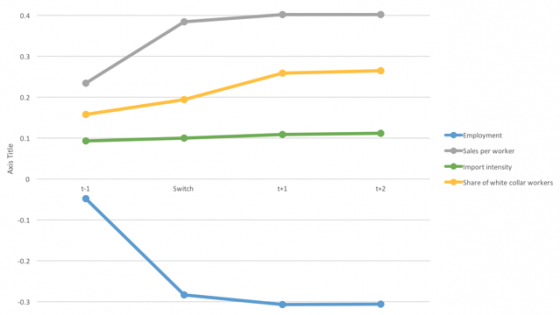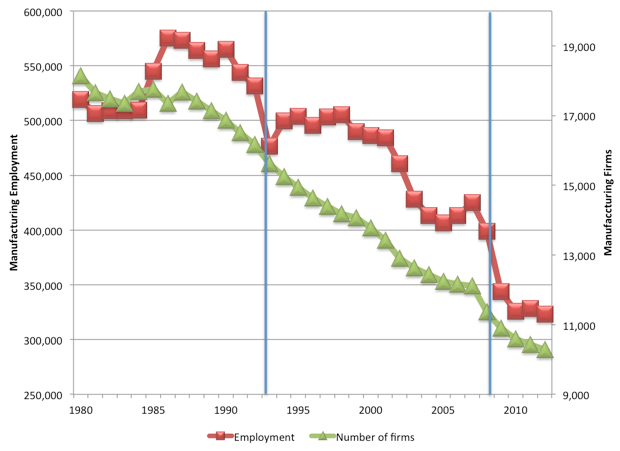Manufacturing employment in high-income countries is on the decline. In the quarter century from 1995 to 2010, the number of manufacturing jobs in the US declined by a third from 18.6 million to 12.5 million. France and Japan had employment drops of 23% and 42% respectively during the same period (Timmer et al. 2014). Their share of manufacturing employment fell even faster, and these trends may now be spreading to countries at even earlier levels of development (Rodrik 2015).
A similar trend can be found in Denmark, a small open economy of 5.5 million people. Manufacturing activity reached a peak in 1986 with more than half a million individuals employed in the sector. Since then, employment has declined by more than 40% (Figure 1).
Figure 1 Danish manufacturing firms and employment over time
Deindustrialisation in advanced countries has attracted a lot of attention and various explanations have been suggested, from differential productivity changes across sectors to comparative advantage and the emergence of China. It is a major source of concern for policymakers, who have designed a significant amount of resources to bring back manufacturing jobs. They worry not only about the wellbeing of workers, but also about the loss of competence and the growth prospect in the long run (though Dadush 2015 argues that high growth can be sustained without relying primarily on manufacturing).
The evolution of firms that switch out of manufacturing
In a new paper, we focus on two questions: first, we ask whether are we measuring the process of deindustrialisation in the right way; and second, how it relates to the future of manufacturing in developed countries (Bernard et al. 2016). Using Danish data, we are ‘rethinking’ deindustrialisation by putting more emphasis on the set of activities that are associated with manufacturing, rather than relying only on the industrial classification to which firms are allocated. In the development, production and distribution of any manufactured good, firms have to carry on a wide variety of core and support activities. Traditionally, a manufacturing firm must necessarily be involved in the production task. We show that firms that have left the manufacturing sector can still perform many of the tasks associated with the creation and delivery of the product, except the production process itself. Our research is related to recent evidence from Bernard and Fort (2015) about so-called ‘factoryless goods producers’ in the US and from Crozet and Millet (2013), who show the increased reliance on services as a source of revenue even for manufacturing firms. We argue that a substantial fraction of the decline in manufacturing is actually reflects the changing nature of firms and production in modern economies.
For this purpose, we conduct an in-depth analysis of firms that switch out of manufacturing, i.e. they are no longer considered as manufacturing firms but they survived and now operate in another sector of the economy. These switchers are small but productive in the year they leave manufacturing, and they become even more productive after switching.
At the end of our sample period, these former manufacturers employ about half of the jobs that had apparently disappeared from manufacturing. Furthermore, we document that switchers can be classified in two distinct categories: those that have stopped any involvement in manufacturing and are conducting the traditional activities of wholesalers; and those that are still involved in some manufacturing activities, mostly focused on the design and distribution but not in production itself. Firms in this second group have engaged in skill upgrading and employ a larger proportion of high-tech workers. In sum, some of these switching firms are no longer counted as manufacturers, but they retain many of the characteristics of producers, minus the production itself. These findings suggest that simply relying only on official figures of employment in firms registered in manufacturing overstates the loss in manufacturing-related capabilities that switchers are likely to have maintained.
We also investigate the determinants of the switch. When comparing the characteristics of switchers relative to firms that remain in manufacturing (‘stayers’) and those that really die (‘exiters’), we notice that switchers are on average smaller, more productive, have a more skilled workforce, and are more import. This trend is even reinforced after switching (Figure 2).
Figure 2 Evolution of switching firms relative to continuing manufacturers
Finally, we consider the individual workers who lose their jobs at firms that switch out of manufacturing. These workers appear to suffer in the short run. Relative to individuals losing their job as a consequence of firm exit, workers losing their jobs at switchers experience a relatively more negative outcome – both a higher probability of unemployment and a large wage loss. However, they recover relatively quickly and five years after losing their jobs, their labour market status and wage trajectory are slightly better than workers at ex ante comparable firms that remain in manufacturing. This indicates that workers in Danish manufacturing reallocated relatively smoothly to new sectors of activity. This might have been facilitated by various features of the Danish labour market, and in particular its so-called ‘flexicurity’ (i.e. the coexistence of flexibility, implying low adjustment costs for both employers and employees, and broad security, owing to a developed social safety net with high coverage and high replacement ratios) and the extent of active labour market policy through which individuals are reoriented or retrained for new opportunities.
The ‘decline’ in manufacturing employment is not simply a story of disappearing industries and failing firms. Modern firms in advanced economies evolve to better face a changing environment and take advantage of new opportunities, in part by transitioning towards more service-like enterprises.
Looking at deindustrialisation from this other perspective also calls for a reconsideration of industrial policy and its goals. In the short run, the emphasis has often been on saving or bringing back jobs in or to the manufacturing sector. Our findings suggest that more attention should be devoted to those service sector firms that still perform many of the high value-added activities of a typical traditional manufacturing firm. Not accounting for these non-manufacturing firms ignores a potentially important component in the modern production economy.
In the long run, economic policies are designed to be welfare improving and to promote long-run productivity growth. Given their relative success after transitioning, policymakers might be inspired to look at the evolution of this subset of firms in the service sector that have the capabilities to produce innovation and generate productivity gains through a different way of organising their activities in the context of broader globalisation. Policies that favour ‘production’, i.e. manufacturing, are going to miss this growing and important set of firms and may bias firms towards retaining less efficient production activities.
References
Bernard, A B, and T C Fort (2015), “Factoryless Goods Producing Firms”, American Economic Review Papers and Proceedings 105(5).
Bernard, A B, V Smeets and F Warzynski (2016), “Rethinking Deindustrialization”, NBER Working Paper 22114, March (paper presented at the 63rd Panel Meeting of Economic Policy in April 2016).
Crozet, M, and E Millet (2013), “Is Everybody in Service? The Servitization of French Manufacturing Firms”, Technical Report, CEPII.
Dadush, U (2015), “Deindustrialisation and development”, VoxEU.org, 13 March.
Rodrik, D (2015), “Premature deindustrialisation in the developing world”, VoxEU.org, 12 February.
Timmer, M P, G J de Vries, and K de Vries (2014), “Patterns of Structural Change in Developing Countries”, GGDC research memorandum 149







